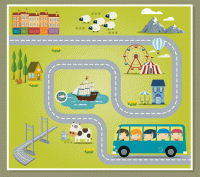The Power of Combining Coaching with a Framework for Teaching
Your content has been saved!
Go to My Saved Content.Like many of us committed to public education, I'm constantly searching for what's working and what can be replicated. This year I've discovered two essential ingredients for any successful school system to be effective. Think of these ingredients as the yeast and flour of any kind of bread -- obvious and essential -- and they must be used in combination with each other. I'll name these two staples as "The Destination" and "The Road Map."
The Destination: Effective Teaching
The first essential component of a journey towards effective schools is a shared agreement about what we're looking for in teacher practice and what constitutes mastery teaching. This agreement needs to be very specific, detailed, and skill-based. In California, as in many states, public school teachers are held to a set of "standards for the teaching profession." Never mind that we don't really ever remember what they are or that we rarely do anything with them, my big complaint about these standards is that they're too general and vague.
Over the last couple of years I've worked with some middle schools in the Oakland Unified School District that are exploring alternative evaluation systems. As part of this work, a team of teachers selected a teaching effectiveness framework and rubric called The College-Ready Promise (TCRP). (This framework is aligned to our state standards, influenced by Charlotte Danielson's work, and is also used by Green Dot Public Schools, some of the Aspire charter schools, and others). The framework has three main parts: Planning and Assessment, Classroom Learning Environment, and Instruction. Two other domains (Professional Responsibilities and Partnerships, Family and Community) are in development.
The first thing I want to emphasize is that the primary way this framework and rubric are being used is to aid in developing teachers. It is what we focus professional development on. It is what we align coaching to. This is a developmental rubric and is being used as a tool for support. I'll talk more about this farther along.
Let me give you an example of what's on this thing. In the domain of Instruction, there's an indicator called "Academic Discourse." Teaching practices of academic discourse are described on four levels. The fourth level is described like this: "Conversations in whole and small group settings are facilitated by students and consistently involve all students in academic discourse among students. Students talk about an academic idea, using academic vocabulary and support ideas with evidence."
This tool has been invaluable in providing clear, concrete descriptions of what we're aspiring to, or looking for in teaching practice. I have observed teacher after teacher review the Level 4 descriptions and make comments such as "Ok, now I know what I need to do."
It's amazing, and sad how often teachers feel like they're trying to perform some kind of magic act, or that every other week they're asked to do something different -- the expectations for teaching have either shifted, or not been defined, or been unclear for so long.
While not perfect, the TCRP framework has given us more to work with than we've ever had in Oakland. The rubric is succinct enough to make it useable but not so long that we drown in it. It is a place from which to start conversations, define a destination, and come to some agreements about what needs to happen in classrooms in order for students to be college-ready.
The Road Map: Professional Development
The piece of the "how are we going to get there?" that I'm most interested in is professional development, and specifically the role that coaching plays in an effective PD program. I have been a coach for many years, I manage a team of coaches, and I believe coaching is an essential lever in transforming schools, but I also recognize that all by itself, a coaching program will have limited impact. Coaching is a vehicle but if we're not really clear on where we're going, we'll meander, perhaps get lost, or end up in some other location or galaxy, which might be okay or might be problematic.
I've written a lot about coaching -- my book, The Art of Coaching: Effective Strategies for School Transformation was just released. I practice a very specific and structured coaching model that according to a number of measurements is very effective. This year I'm really seeing a positive impact on teaching practice (and student learning) by combining a strong coaching program with a clear framework for teaching.
With the TCRP in hand when coaching teachers, we now have very clear descriptions of which skills we're trying to build. We have a focus. And by staying focused and having clear goals, teachers are making fast growth. And students are learning more.
There are no panaceas in public education, I remind myself over and over. I wish there were. But some elements are essential in order to transform our schools. Having an agreement on where we want to go and what we want to see is the first essential; having a program for professional development towards that end is the second.
